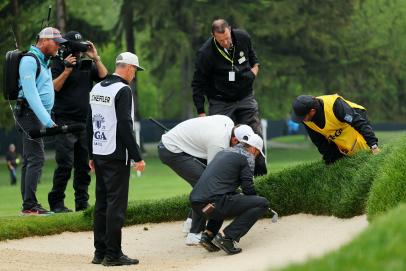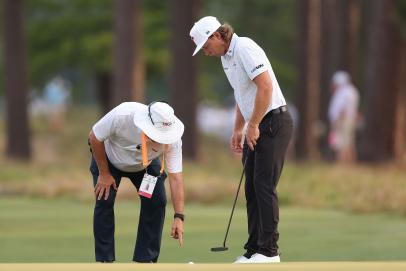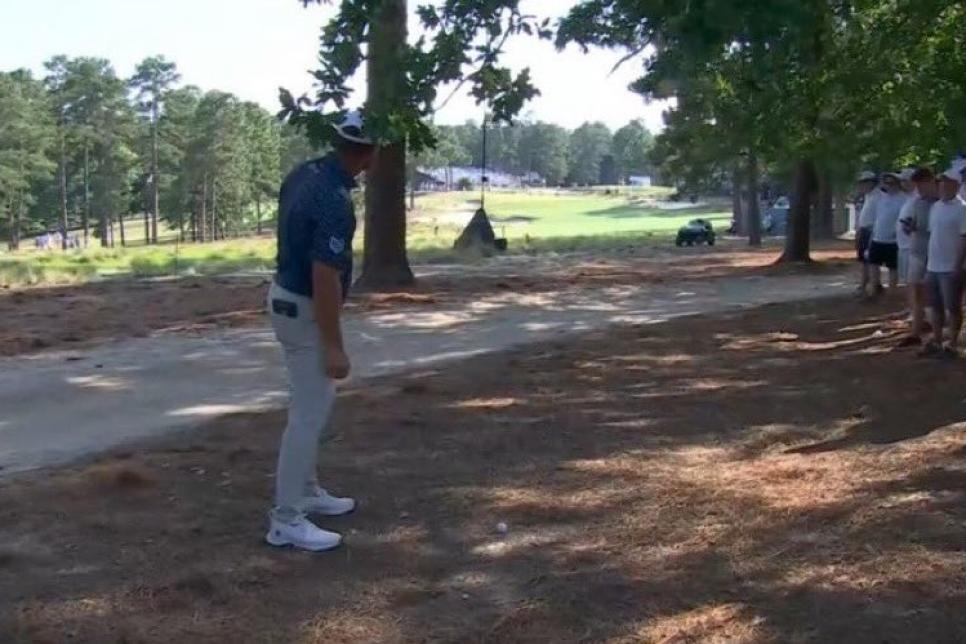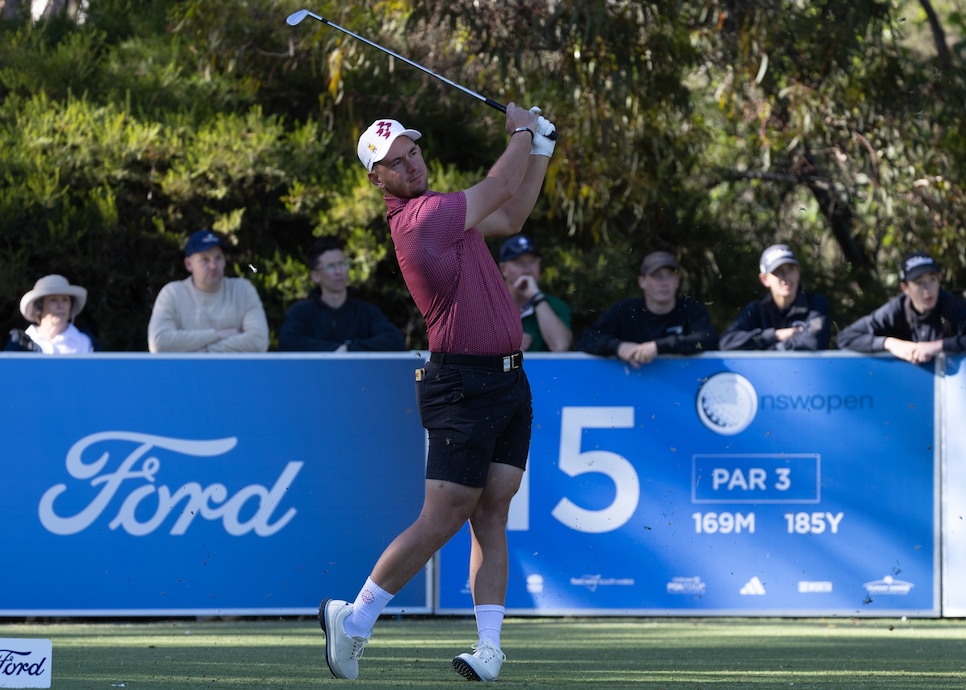Rules of Golf Review: Tour pros get relief from grandstands all the time. So why can’t I move my ball when it’s behind an electrical box? – Australian Golf Digest

- by Admin
- June 19, 2024

Watch pro-golf tournaments long enough and you’ll be amazed at some of the breaks players seem to get thanks to the construction of grandstands, hospitality tents, TV towers and more. In fact, it’s not all that unusual for tour pros to take temporary immovable obstructions (TIOs) into consideration when playing shots.
One recent example—and arguably the most outrageous we can remember—of a tour pro taking advantage of the free “line of sight” relief granted from a TIO came from Jordan Spieth at the Valero Texas Open in March. Trying to escape a dicey lie in a penalty area on the 18th hole at TPC San Antonio during the third round, Spieth purposely hit his third shot into the gutter of the clubhouse behind the green, knowing that building was not marked out of bounds. He got relief from the clubhouse, but that meant his ball was now behind a scoreboard on his line to the hole. That allowed him to take more free relief from this TIO, giving him eventually a clean shot into the green. As it turns out, he made a double bogey on the par-5 hole, but he did give himself a par putt with all those crafty moves.
If you were watching or just read about it, you might be wondering why pros get free relief for stuff like that but you can’t move your ball without penalty when there’s an irrigation box or some other permanent structure between your ball and the hole.
More From Golf Digest Rules 101 Rules Review: How can I possibly know ‘exactly’ where my ball crossed into a penalty area?  Rules Are you smart enough to ace this basic Rules quiz?
Rules Are you smart enough to ace this basic Rules quiz?  Rules U.S. Open 2024: What goes on inside the rules office at a major? We got a glimpse
Rules U.S. Open 2024: What goes on inside the rules office at a major? We got a glimpse
Rule 16 outlines relief from abnornal course conditions. It covers what you can and can’t do when encountering immovable obstructions on the golf course. These include cement cart paths, ball washers, snack bars—anything that is not out of bounds and when your ball is anywhere on the course except for a penalty area. The rules state that you are allowed one club-length of free relief (complete relief) from the obstruction so long as your ball isn’t any closer to the hole after the drop and that it’s in the general area of the course. This relief applies, however, only if the immovable obstruction interferes with your ball, stance or swing.
Notice we didn’t say “line of sight.”
Indeed, line-of-sight relief is available only with temporary immovable obstructions. The logic is that the temporary objects shouldn’t be there. And TIO relief requires a course/tournament, like those on the PGA Tour, having put Model Local Rule F-23 in place. That MLR states:
“TIOs (such as a grandstand or a tent) are not normally present and are not considered to be part of the challenge of playing the course. Because of their temporary nature, this Local Rule provides an additional relief option that is not allowed from immovable obstructions, although the player can still choose to treat the TIO as if it were an immovable obstruction and use the relief procedures available in Rule 16. The additional relief provided by this Local Rule includes the ability for a player to take relief when the TIO is located on the straight line between his or her ball and the hole (known as “line of sight relief”) by moving sideways, keeping the same distance from the hole, so that the TIO is no longer between the player’s ball and the hole (also known as moving along the “equidistant arc”).
“When a player takes relief from a TIO, whether under this Local Rule or the relief procedures in Rule 16, the player is guaranteed complete relief from physical interference. But only when relief is taken using the additional relief option under this Local Rule will the player be guaranteed complete relief from the TIO being on his or her line of sight.”
TIO relief was part of the discussion last week during the U.S. Open at Pinehurst. Within minutes of each other during Thursday’s first round, Bryson DeChambeau (on the fifth hole) and Scottie Scheffler (on the 16th) both received line-of-sight relief from a ShotLink tower on each hole. The tower itself is fairly narrow, but the triangle base is large enough that the USGA followed the PGA Tour’s lead and considered it a TIO ahead of the championship.
Golf fans on social media were up in arms that both players had much clearer shots after getting the relief, but they were just taking advantage of the rule.
“Sometimes you’re lucky, and sometimes you’re not,” DeChambeau said. “In that situation, I was very lucky.”

Rules officials agreed that the ShotLink Tower on the fifth hole was in DeChambeau’s line of sight during the first round of the U.S. Open. So …

He was allowed to take complete relief to the left of where his ball came to rest and had a clear second shot.
Reading this, you might wonder how often players consider a type of shot or line of play that they wouldn’t otherwise choose because they know there’s the potential they could get free relief from an otherwise messy situation. In other words, do players try to “bend” the Local Rule to move into a better position on the course?
We’re not saying it never happens, but rules officials also often deny TIO relief to a pro who might be trying to game the system. On the 18th hole during the final round of the U.S. Open, after DeChambeau’s tee shot came to rest beside a root with the tree interfering with his back swing, he asked rules officials if the nearby grandstand could be considered a TIO. The official said no, that it wasn’t in his line of sight. DeChambeau had to play his awkward second shot, which wound up in a bunker 55 yards short of the green. That then led to his incredible sand shot that set up the four-footer for par that secured him the victory.
Sometimes, however, officials do accept the player’s request, as was the case for Jon Rahm in the 2023 Genesis Invitational. The Spaniard hit a wild drive on the third hole of Riviera Country Club during the third round, but got away with it because his ball landed in a staging area for tournament equipment. While you would be likely calling for a lost ball or an unplayable lie after a tee shot like that and likely carding a double bogey or worse, Rahm got relief and managed to save par on the hole.
The lesson here? Well, either get good enough at golf to play in tournaments or just shake your head and chalk up TIOs as yet another benefit of being a tour pro.
MORE GOLF DIGEST RULES REVIEWS
What do I do if my ball just hit another ball on the green?
Can you chip a ball on the tee while waiting for the group ahead of you to play?
I hit myself with my own ball. Is that a penalty anymore?
What exactly is an embedded ball?
I hit a horrible shot. I’m way better off if I don’t find it. Can I just declare it lost?
When does the three-minute search time for a lost ball actually begin?
Does a ball have to be unplayable to declare it unplayable?
I accidentally hit my ball with a practice stroke … does it count?
I’m on the green. My opponent is not. Who’s away?
I bent my putter and it actually works better. Can I still use it?
Somebody just picked up my golf ball! Now what?
This article was originally published on golfdigest.com
The Latest News
-
November 14, 2024Huge crowd floods tiny town to watch Aussie superstar
-
November 14, 2024Made from South Australia: Adelaide Football Club unveils bold brand for a new era via Fuller
-
November 14, 2024No, cricket is no longer the national sport, its window is getting smaller and smaller
-
November 14, 2024Aussie makes history with most powerful job in rugby
-
November 14, 2024Australia Post unites HR support with new ‘front door’ and tech platform




